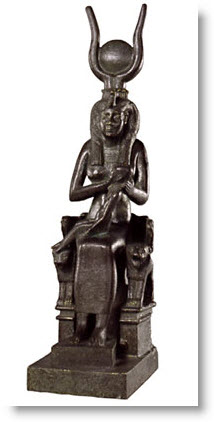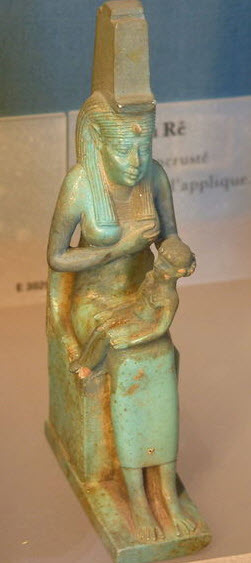Isis
This page is about the Egyptian goddess Isis.
Isis is the Greek name of Aset (or Iset), the goddess protector and savior of the Egyptian mythology. She is part of the great Ennead of Iunu (Heliopolis).
Isis seems to have been in ancient times the personification of the throne, her name in hieroglyphics being Iset, meaning "the seat". In the inscriptions, Isis is depicted as a woman wearing a head (which looks like a stool with three steps).
Later, its representation changes: we see Isis as a woman wearing cow horns enclosing a lunar globe (Not to be confused with Hathor).
Mother goddess

Isis (Egyptian Goddess)
Isis may be the heir of a prehistoric mother goddess venerated in the Nile Delta, where, according to the myth she raised the child Horus. Isis has also been associated with a Mesopotamian demon, the Lilith myth of Gilgamesh. At the end of the fifth dynasty, Isis is mentioned in the Pyramid Texts, where she protects the deceased king from putrefaction. Ramses and his successors built shrines to Isis in Memphis and Abydos in particular. During the Greco-Roman era, Isis became the universal goddess, invoked both in Egypt than in the Mediterranean and beyond. The Temple of Philae on the Nile was dedicated to Isis. This temple had to be moved to the island Agilkia because of the Aswan Dam.
Isis and Horus
Isis is the Great Goddess par excellence.
In the myth of Osiris, she is the depicted as the perfect wife and sister, who, with her magical powers and with the help of her sister Nephthys, succeeds in resuscitating her brother and husband, so that their union can produce their son, the god Horus.
Seth was jealous of his brother Osiris, and wanted to get rid of him. He built a precious wooden box and declared during a banquet he would give the box to whoever was able to adjust his body to the box's exact dimensions. Osiris, who was very large, squeezed into the box and then Seth, with his 72 accomplicaes - representing the 72 demi-gods of the decanates of the zodiacs, closed the heavy lid on the box and sealed it with molten lead. Then Seth and his accomplices carried the casket on the Nile and brought Osiris down to the sea.
The chest of Osiris, carried by the currents of the Mediterranean Sea, found its way to Bybloz, in Phoenicia, where it collided with the trunk of a tamarisk. Isis, having set out on a boat in search of her husband, came to Byblos and retrieves the casket, which she returns to Egypt and hides in the swamps of the delta.
But while hunting by moonlight, Seth found the body of Osiris which he cut into fourteen pieces and scattered in all directions.
Isis then went back on her boat of papyrus in search of the pieces of the body of her beloved, through the maze of marshes, but she found only thirteen of the fourteen. The only part not found, despite all her efforts and the help of obliging crocodiles, was the Osiris's penis as it had been eaten by fish. However, before it was consumed by the fist, Osiris's organ gave its fertilizing powers to the Nile river.
Undaunted, Isis constructed an artificial phallus for Osiris out of clay, which she then consecrated. Isis resolved to make an artificial phallus clay and anointed. She then breathed life back into the body of Osiris, and the two conceived a son, the god Horus.
This myth of Osiris legitimized, or perhaps was the reason for, the ancient Egyptian custom of marrying brothers and sisters of the royal family in order to preserve the pure blood and royal family, and also to perpetuate the divine rite which made them gods (as Pharaoh and Queen were considered gods).
Isis symbolized the feminine principle in nature. As a magician who brought Osiris to life, she is also a healing goddess and protector of children. Patients sometimes wore amulets bearing his image.
As a mother of Horus, Isis was regarded as a life-giving goddess and guardian who watches over her child. In this role, she is often represented as Lactans Isis in Roman times, carrying the infant Horus in her arms and giving her breast.
As the widow of Osiris, she is a patron deity of the deceased. With Nephthys, Neith and Serket, she is the guardian of the sarcophagus.
Attributes
Isis took the appearance and attributes of several goddesses - Serket, Hathor, Neith and Nut - to melt into a single deity.
Her attributes which she shares with other deities, are:
- The ankh, the ankh symbol of life;
- The sitar and the necklace menat of Hathor;
- The solar disk and horns of Hathor;
- The cap-shaped vulture attribute celestial goddesses, before being shown with the vulture headdress she wore a crown-shaped throne.
Isis was regarded as a good goddess, a protector of mankind. A prayer recorded on a papayrus written 2200 years ago, attests to the faith that ordinary Egyptians placed in her:
Isis, ... goddess of many facutlies, honor of the feminine sex ... ... loveable, who makes sweetness reign in the assemblies, ... ... enemy of hatred .... You can reign in the Sublime and the Infinite. You can easily trump the despots with your loyal advice. ... It is you who, alone, found your brother (Osiris), steered well the boat, and gave him a burial worthy of him. ... You want women (of childbearing age) to join the men. ... You are the Mistress of the Earth ... You have made the power of women equal to men!
Greek and Roman pantheons
The Greeks and Romans, brought Isis into their respective pantheon.

Isis as the Great Mother breast feeding her son, the god Horus.
This image is available under a Creative Commons License.
Under the Ptolemies, Isis crossed the borders of Egypt. She was seen as an aspect of many Greek and Roman goddesses such as Demeter, Persephone, Dictys of Diane, Selene, Ceres or Minerva Cécropienne.
Rome officially adopted Isis as a state-approved goddessin imperial times. At Pompeii, she was adored with Osiris-Serapis and Anubis. The Emperor Caligula was a devotee of Isis. In his villa at Tivoli, Hadrian built a temple dedicated to the husband of the goddess, Osiris-Serapis; Caracalla built a temple of Isis at Rome itself.
The worship of Isis as the goddess of salvation spread through the Roman provinces around the Mediterranean but also in Pannonia, Gaul, sometimes giving her name to sites such as that of Izieux (Place of Isis) south-west of St. Chamond in the Loire department as on the Rhine and Britain. Like Demeter of Eleusis, Isis, through her Mysteries, assured immortality to the faithful. In the later Empire, only the initiatory cult of the god Mithras Iranian surpassed that of Isis in the number of faithful followers. Even after the advent of Christianity, many Romans continued to worship Isis at the Temple of Philae and elsewhere. The cult of Isis at Philae was not extinguished until about 535 A.D., under Emperor Justinian.
Another major shrine is the temple of Isis at Behbeit el-Hagar. Other temples to Isis as found throughout the Roman world in Africa, Libya, Tunisia and Sudan, the Middle East, Jordan, Turkey and Lebanon, as well as Europe, Greece, Italy, France, Germany ( Sanctuary of Isis-Mater Magna Mainz) and Spain.
pyramids Egypt Mummies Search Engines Link Report
Egyptian Cities | Egyptian Education | Ancient Egypt | egyptian clothing | Egyptian Houses | The Egyptians | Egyptian Family Life | Egypt and its Neighbours | Government in Ancient Egypt | Egyptian History | Military | Organization of Ancient Egypt | Recreation | Egyptian Religion | Pyramids | About | Privacy Policy | Site News | Site Map
EgyptPast.com - Facts and Information About the History of Ancient Egypt
-